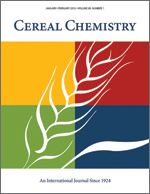
Cereal Chem 52:513 - 532. | VIEW
ARTICLE
Single-Kernel Analysis of Gluten: Use in Wheat Genetics and Breeding.
J. A. Bietz, K. W. Shepherd, and J. S. Wall. Copyright 1975 by the American Association of Cereal Chemists, Inc.
Because of the importance of glutenin proteins in determining wheat flour quality and dough properties, new methods were developed for examining glutenin's subunit composition in hexaploid and tetraploid varieties with known genetic differences. Glutenin was quantitatively extracted from single kernels, and its subunit composition observed by sodium dodecyl sulfate-polyacrylamide gel electrophoresis. In the variety Chinese Spring, the five highest molecular weight (mol wt) subunits (1: 133000 mol wt; 2: 104000 mol wt; 3: 93000 mol wt; 4: 86000 mol wt; and 5: 68000 mol wt) are coded by the long arms of chromosomes 1B (subunits 2 and 3), 1D (subunits 1 and 4), and 4D (subunit 5). Analysis of genetic stocks which contain these markers for chromosomes related to quality may permit selection or development of improved varieties; half-kernels may be examined, and lines maintained by growing germ ends. Hexaploid wheats were also compared with durum and derived tetraploid wheats, which lack the entire D genome. Most tetraploid wheats lack glutenin subunits 1, 4, and 5, but only subunit 4 is consistently absent, and in many varieties considerable variability occurs. Hexaploid varieties, however, are more uniform in glutenin subunit composition.